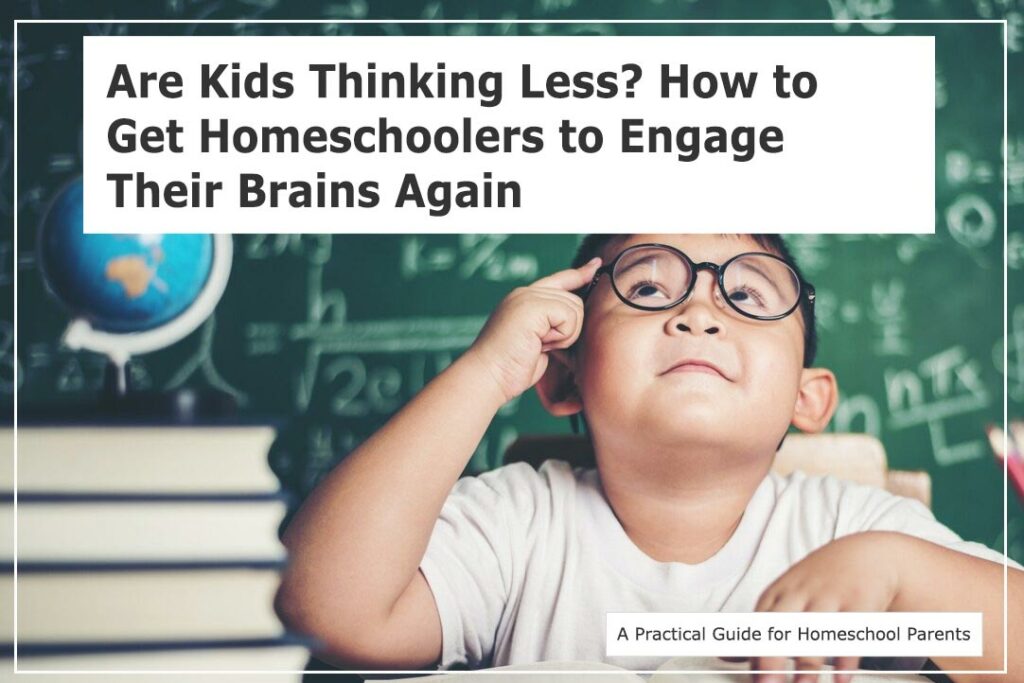As a teacher, I’ve noticed a growing trend in classrooms: kids just aren’t thinking as much as they used to. I ask a question, and instead of eager responses, I see blank stares. Many students seem to be waiting for me to answer my own question, rather than engaging in problem-solving themselves. It’s not just in my classroom—many teachers are reporting the same thing.
If you're a homeschool parent, you might be seeing this, too. Maybe your child hesitates to answer questions, avoids struggle, or gives up quickly when a problem isn’t immediately clear. It can feel frustrating, but you’re not alone! This is part of a larger trend affecting many kids today.
The good news? With the flexibility of homeschooling, you have powerful tools to break this cycle and get kids thinking deeply again. Let’s dive into why this is happening and, more importantly, how to fix it.
Why Are Kids Engaging Less?
1. They’re Used to Instant Answers
Kids today are growing up in a world of Google, YouTube, and AI chatbots that provide answers instantly. Instead of working through a problem, they’ve learned they can just look it up.
At home, this might look like:
Your child asks a question, and before they try to figure it out, they Google it.
They watch tutorial videos that show the solution without requiring them to think.
They struggle for two seconds before asking you for help instead of trying different approaches.
2. Fear of Being Wrong
Many kids today are hesitant to take risks in thinking because they fear being wrong. Social media and gaming culture often create a pressure to perform perfectly, making them reluctant to guess or struggle.
At home, this might look like:
Your child freezes when faced with a tough math problem instead of making an attempt.
They avoid open-ended discussions where they can’t be sure of the “right” answer.
They get frustrated and shut down when they don’t succeed immediately.
3. They’ve Been Trained to Wait for Help
Many students have been over-scaffolded in learning. Whether in schools or at home, they’ve gotten used to adults stepping in too quickly when they don’t understand something.
At home, this might look like:
You explain a concept before they even get a chance to struggle with it.
They don’t attempt a problem on their own because they’re waiting for you to walk them through it.
If they don’t immediately know an answer, they say, “I don’t know” and stop trying.
4. Short Attention Spans & Digital Distractions
With social media, fast-paced video games, and short-form content like TikTok, many kids are used to constant stimulation. Sitting with a difficult problem for an extended period feels boring or frustrating to them.
At home, this might look like:
Your child quickly loses focus when doing a challenging subject.
They resist activities that require patience and deep thinking.
They prefer learning through passive content (videos, tutorials) instead of active problem-solving.
How to Get Your Child to Engage & Think Again
As a homeschool parent, you have a huge advantage over classroom teachers: you can tailor learning to your child and adjust as needed. Here are seven strategies to rebuild their problem-solving muscles:
1. Use "Wait Time" to Make Them Think
When you ask a question, don’t answer it yourself if they stay silent. Just wait. Let the silence feel uncomfortable if needed. Many kids are used to adults filling the silence for them. If they don’t answer, rephrase the question but still don’t give the answer.
2. Resist the Urge to Jump In Too Soon
If your child struggles, it’s tempting to step in and help right away. But struggle is where real thinking happens! Give them space to try first, even if they fail.
3. Use Random Selection for Answers
If you have multiple kids, avoid calling on the first person who raises their hand. Instead, use random selection so everyone stays engaged.
4. Turn Learning into a Game or Challenge
Many kids disengage because they see school as something to get through rather than something interesting. Adding friendly competition can help.
5. Ask More “Why” and “How” Questions
Instead of questions with single-word answers, ask open-ended ones that force them to explain.
6. Use Hands-On, Real-World Activities
Many students engage more deeply when they experience learning rather than just hearing it.
7. Don’t Let Them Give Up Easily
If your child shuts down too quickly, gently push them to keep trying.
Final Thoughts
If your child seems disengaged, don’t panic—it’s happening in classrooms everywhere. But with small changes in your homeschool approach, you can retrain their brain to think deeply.


